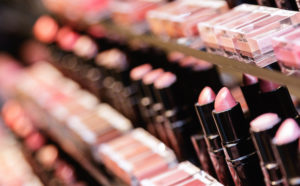
Scholars reflect on the need for stronger regulatory oversight of cosmetics in the United States.
Claire’s—an American retailer of accessories, jewelry, and cosmetics geared toward children—reportedly removed several personal care products from its stores in the spring of 2019 after the U.S. Food and Drug Administration (FDA) announced that the items contained asbestos. Had it been a store selling tainted food, FDA could have forced a recall. But because the potentially dangerous products were cosmetics, FDA could only warn consumers.
Cosmetics, commonly described as personal care products meant to cleanse or beautify, are part of an industry that has largely self-regulated for nearly a century. The Personal Care Products Council (PCPC), a cosmetic industry advocacy group, has funded for decades the Cosmetic Ingredient Review (CIR), a private organization that assesses product safety. But critics question the independence of the CIR. One organization, the Women’s Voices for the Earth, has argued that the “conflict of interest is not just glaring, it’s dangerous.”
FDA’s Office of Cosmetics and Colors has fewer than 30 staff members tasked with monitoring and regulating cosmetics—an industry generating about $70 billion annually. This modest number of federal overseers may not be surprising given that the United States has banned fewer than a dozen chemicals in cosmetics. The European Union, by contrast, has banned over 1,600 chemicals.
Scott Faber of the non-profit Environmental Working Group, reportedly observed that it is “hard to think of a category that is less regulated than cosmetics.” U.S. Representative Frank Pallone, Jr. (D-N.J.) seemed to agree when he lamented that cosmetics are subject to “effectively no regulation.”
FDA’s authority to regulate cosmetics was established by the Federal Food, Drug, and Cosmetic Act (FDCA) in 1938, but FDA could only regulate adulterated or misbranded products. Cosmetics deemed “consumer commodities” later became subject to regulation under the Fair Packaging and Labeling Act. But aside from color additives, which require FDA approval, cosmetics can largely be sold based on manufacturers’ safety claims without any government verification.
Even if FDA had stronger regulatory authority over the cosmetic industry, it also lacks the resources to inspect the millions of cosmetic shipments imported into the United States each year. This oversight gap has made it easier for foreign companies—which are not required to register with the FDA—to sell products later discovered to contain dangerous levels of mercury.
The FDA Cosmetic Safety and Modernization Act and the Personal Care Products Safety Act—two bills designed to address the lack of regulation in the cosmetic industry—never reached the Senate floor for a vote, but have received endorsements from various companies and consumer safety organizations.
This Saturday Seminar highlights research papers that explore current cosmetic regulation and the future of personal care product safety.
- In an article published in the Pace Environmental Law Review, Baruch College’s Valerie Watnick writes that current regulatory proposals to improve the safety of cosmetics in the United States “do not go nearly far enough to make human health a priority.” She argues that the American approach to cosmetics regulation should aim to protect consumers from harm. Watnick claims that an effective regulatory regime should allow FDA to recall products and “require pre-approval of cosmetic formulations and ingredients.”
- The lack of adequate FDA regulation of the cosmetics industry disproportionately affects women’s health—particularly women from socioeconomically disadvantaged groups, claims Marie Boyd of the University of South Carolina School of Law in an article in the Yale Journal of Law and Feminism. Boyd also argues that the failures of cosmetics regulation may be attributed to the cosmetics industry’s “longstanding and close association with femininity and women, and women’s exclusion from political participation and representation.” Boyd argues that the regulation of cosmetics remains “largely unchanged” since the FDCA’s enactment in 1938. For example, she highlights the “minimal” staffing and resources FDA has allocated for regulating cosmetics, levels that experts have called “clearly insufficient.” Boyd calls for strengthening cosmetics regulation to protect women’s health.
- The European Union banned the use of animals in cosmetics safety testing in 2010, which enhanced the need for animal-free safety methodologies. Vera Rogiers of the Free University of Brussels-VUB and her coauthors examine a “next generation risk assessment” (NGRA) as a potential alternative framework for the safety evaluation of cosmetic products. The NGRA framework uses in-vitro testing on human cells “to modernize the science of toxicological safety evaluation.” Rogiers and her coauthors urge the cosmetics industry and regulators to work together to continue to develop NRGA processes.
- The Federal Trade Commission and FDA have not provided a clear definition of “natural cosmetics,” William A. Hanssen and Katie M. Jackson of Faegre Drinker Biddle & Reath argue. In an article published in The National Law Review, they write that this ambiguity has led to litigation against cosmetic manufacturers. They note, however, that a 2019 bill called the Natural Cosmetics Act could have amended the FDCA to define “natural” and “naturally derived ingredient” in cosmetics. Hanssen and Jackson argue that defining these labels could help cosmetic companies avoid litigation by providing clearer guidelines for advertising natural products.
- Numerous chemicals from personal care products have seeped “into drinking water supplies and aquatic ecosystems throughout the United States,” attorney John Wood argues in an article for the NYU Environmental Law Journal. Wood discusses how the FDA regulation under the FDCA and other federal regulation fail to address adequately personal care products’ environmental impacts. He contends that “with creativity and regulatory initiative,” the United States should be able to address these impacts through a patchwork of existing federal legislation.
- Cosmetics too often contain endocrine-disrupting chemicals shown to increase the risk of cancer as well as lasting damage to cells, both of which parents can pass on to future generations, argues Katherine Drabiak of the University of South Florida in the Pace Environmental Law Review. She shows how the Hogans v. Johnson & Johnson litigation demonstrated the lack of FDA oversight in cosmetics under the FDCA. Until the United States develops a more precautionary approach to regulating cosmetics, cancer rates will likely continue to increase, Drabiak argues. She cautions that the current regulatory system fails to keep consumers safe from toxicants that likely increase their offspring’s “risks of cancer, fertility issues, neurological deficits, and immune dysfunction.”
The Saturday Seminar is a weekly feature that aims to put into written form the kind of content that would be conveyed in a live seminar involving regulatory experts. Each week, The Regulatory Review publishes a brief overview of a selected regulatory topic and then distills recent research and scholarly writing on that topic.



